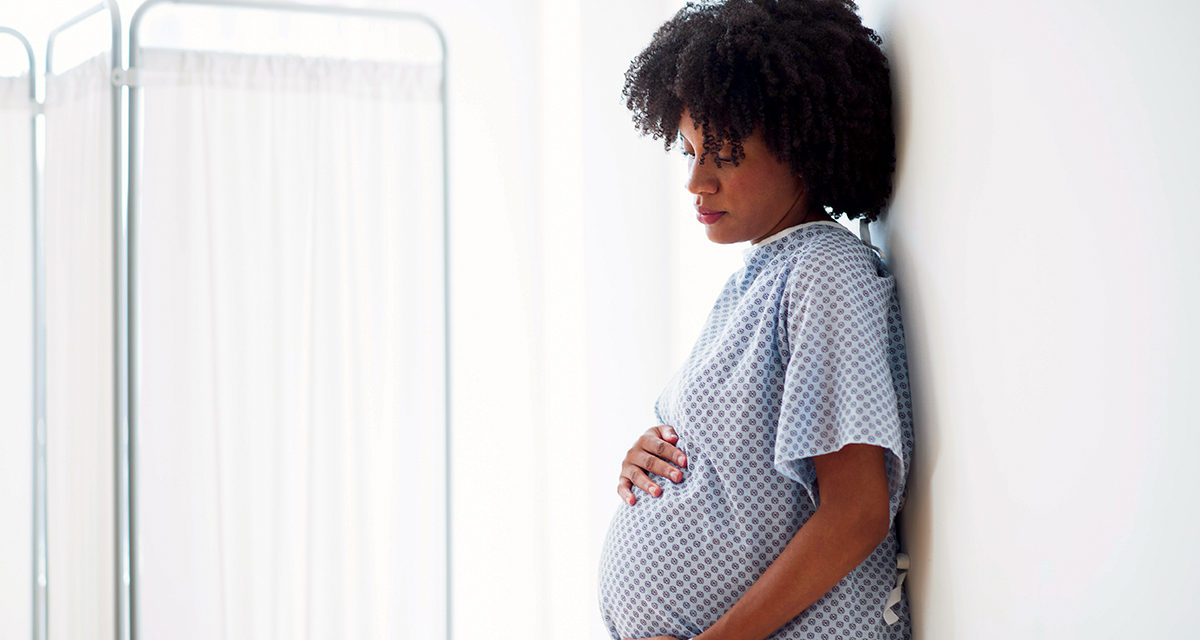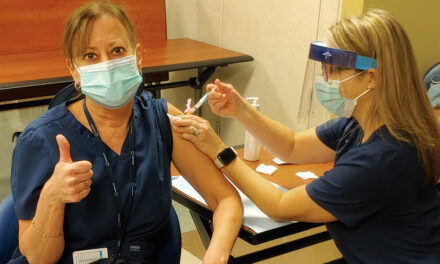Statistically, the maternal mortality rate in the United States is abysmal compared to that of other developed countries, but most of those deaths are preventable. Here’s what Capital Health is doing to protect the moms (and babies) in their care—and what you need to know to be part of the solution.
At four-foot-nine-inches tall, Lilian Seiders had to stand on a wooden box to pose for the portrait of her and her husband, Tilghman, that hangs in my home today. It’s the only photo I have of my paternal grandparents, in part because she slipped away 3 days after giving birth to my father. Before Lily died, she asked her sister-in-law, Bessie, to care for her baby, who she named Monroe, from “mono” for “one.” In truth, he was her fifth child—but the only one who would ever draw breath. When the doctors told Lily that her frame was too tiny to enable her to deliver a live child the traditional way, she volunteered to be the first C-section patient in the hospital where she gave birth. She knew the odds were not in her favor, but she was bound and determined that this baby would live. I am here today because she traded her life for his.
What happened to my grandmother after delivery was lost to history. Perhaps no one in my family ever really knew—we Pennsylvania Dutch rarely talk about tragedy. All I know is that she did not make it. What I can’t help but wonder is whether she would have survived, had she given birth today.
What’s going on with the maternal death rate in America?
Between 1990 and 2015, the worldwide maternal mortality ratio (or the number of deaths per 100,000 live births) dropped by about 44 percent. In fact, the numbers in most developed nations dropped by about 48 percent. England’s count (which was already lower than America’s in 1990), fell from 10.5 to 8.8. Then there was America…
In that same 25-year span, as medicine overall benefitted from advances in medicine and technology, statistics showed that America’s MMR climbed from 16.9 to 26.4—an increase of more than 56 percent. Real Woman reached out to Capital Health obstetrician Kira Przybylko, MD, to ask “What gives?” And “What can we do about it?”
“I think it’s a combination of things,” she began. “For one thing, the metabolic profile of the United States may not be the same as in other countries.” Italy, for instance, whose Mediterranean diet is often touted as the recipe for better health reported an MMR of just 4.2 in 2015. Our country’s widespread struggle with obesity and the related complications and conditions, she says, may account for some of the rise in postpartum problems. “Moms are coming in with more medical problems than I’ve ever seen before,” she notes.
Research backs her up: According to a recent University of Michigan study, complications from pre-existing chronic health conditions account for one-third of maternal deaths, making this the fastest rising cause of maternal mortality. Our most recent nationwide epidemic—substance-use disorders, including the opioid crisis—has certainly not helped matters. In the last decade, the number of pregnant moms using amphetamines has doubled and the number using opioids has quadrupled, putting both mom and baby at risk for a complicated delivery.
Dr. Przybylko adds that more moms are waiting until later in life to have children, making them more likely to have multiple births, which carry additional risks during pregnancy and delivery. Interestingly, moms in their 40s have a higher incidence of twins and other multiples naturally, even if they don’t undergo fertility treatments.
There’s a lot of discomfort and even pain in pregnancy that is normal. It’s a real trick sorting out what is normal and what is
not.
Lessons from a Capital Health NICU Nurse
Capital Health has the only Regional Perinatal Center in Mercer and Bucks County (located at Capital Health Medical Center – Hopewell), which includes Maternal Fetal Medicine, Maternity, and both a Level II and Level III NICU. Nurse Manager Diane Patterson MSN, RNC-NIC, of the Neonatal Intensive Care Unit shares why she is proud to call this facility her home away from home.
Round-the-clock care: “We’ve always been a Level III NICU, and we’ve always had 6 board-certified neonatologists. One of them is on-site in the hospital 24/7, and during the week, there are two here at all times.”
Research-based practices: “We standardize our process, so we get it right every time. Research has proven that doing the same things for every baby during the Golden Hour—the first hour of life—provides the best outcomes. But it never stops evolving. We benchmark ourselves against the Vermont Oxford Network. There’s always a better way to do something. If you raise the bar, it only makes you better.”
Mom-baby bonding: “We’re a Baby-Friendly Hospital, so we try to keep the mom and baby together. We also provide support for breastfeeding. We even have donor milk for mothers who have trouble at first. Not every hospital administration will agree to that. It’s very, very expensive.”
Family support: “Hopewell was also the first site in New Jersey to house the March of Dimes Family Support program. We have a person from that organization on site part-time to provide support to families with babies in the NICU.”
Patient support: “We have a very engaged multidisciplinary team of staff that are always on the floors, so it is easy for moms to reach out and ask for help. No question is too silly. We don’t make anyone feel inadequate. Being silent is the worst thing you can do if you think there’s a problem. Babies are not silent! They’re always telling us what they need. We just have to listen until we find what’s best for them.”
What’s the role of healthcare?
“There’s a big disparity in our country regarding access to care,” says Dr. Przybylko. “In countries with nationalized healthcare, everybody has the same access.” Better care—regular prenatal visits, patient education, trained medical professionals on site during delivery, state-of-the-art facilities, and so on—leads to better outcomes for mother and baby. Countries with national healthcare also have the ability to standardize protocols for labor and delivery across the board, says Dr. Przybylko, which America has yet to do.
We can’t even seem to gather reliable and accurate statistics on America’s MMR, notes ProPublica, an independent, nonprofit newsroom that investigates abuses of power and trust. (This from an article last year titled, “How Many American Women Die From Causes Related to Pregnancy? No One Knows.”)
Recent changes have been made on how maternal deaths are identified and recorded, in an effort to collect more accurate data. One such measure involved adding a checkbox on death certificates indicating a recent pregnancy. Some of these changes in reporting may account at least in part for the apparent statistical rise in our MMR. However, having been pregnant before dying does not, in itself, imply causality.
Why is this worse among women of color?
Even in studies that account for economics and access to care, women of color in the U.S. have a higher maternal mortality rate than non-Hispanic whites. In a New York City study that looked at the city’s MMR from 2008 to 2012, compared to women of every other race and ethnicity, black women were more likely to die after giving birth. This was true regardless of their level of education, pre-baby weight, or presence of a chronic medical condition. Case in point: Serena Williams and Beyoncé are two examples of women of color who should have had the odds stacked in their favor—but suffered traumatic birth experiences, nonetheless. Both delivered via emergency C-section due to pre-eclampsia.
What accounts for the disparity? “It’s a combination of things,” says Dr. Przybylko. “Access to healthcare is one. There is probably a higher rate of underinsured women among minorities. These women are also are [genetically] at higher risk of some underlying medical conditions, such as diabetes, heart disease, and high blood pressure, which can cause birth complications. But there’s also this big unknown.”
The thread running through numerous articles by and about other women of color who have had similarly harrowing birth experiences is this: implicit bias. Bias based on race, conscious and unconscious, still is woven throughout American society and its institutions. One professional black woman wrote about her doctor’s dismissal of her desire to avoid a C-section—which resulted in hemorrhaging that nearly killed her. Another mother who is both black and Latina reported a series of microaggressions: She was repeatedly asked if her children all had the same father (yes, they do), and she reported that if she was late to an OB appointment, she was hassled, while a tardy white woman was ushered in, with empathy.
What do pregnant women need to know?
The reality is this: According to the World Health Organization, most maternal deaths are preventable. What this means is that there is room for improvement—and as an agent of their own healthcare, women can play a part, as can the healthcare providers to whom they entrust their care and their life.
As a Level III hospital, Capital Health Hospital – Hopewell, has a Laborist Service, which means that the facility is staffed 24/7 with an in-house obstetrician, pediatrician, and anesthesiologist. “If someone rolls in off the street and is in labor, there is always a doctor there,” says Dr. Przybylko. “Other hospitals aren’t obligated to have that. We also have maternal fetal medicine specialists on site and, of course, all the other departments are represented.”
Capital Health nurses are very well-trained, and, perhaps equally important, they advocate for their patients at every turn, she says. “They’re very good at notifying the doctor,” says Dr. Przybylko. “They don’t worry if we’re busy. They just call us if they need us. I don’t know any nurse that’s scared to call the doctor.” This is vitally important because being heard is the first step toward being helped. Capital Health is so dedicated to compassionate care that it partners with the DAISY Foundation to recognize particularly empathetic nurses with the DAISY Award for Extraordinary Nurses.
Another important point: The labor/delivery nurse at Capital Health is not also the pediatric/baby nurse, which means one nurse can focus only on the mom and the other on the baby. Moms remain in their labor-and-delivery room for a few hours after giving birth, monitored closely by their nurse until they are deemed stable or in need of extra care. During that time, the nurses follow standard protocols to monitor things like blood pressure, temperature, and bleeding, which can be early warning signs
of a complication.

What can pregnant women do?
Being proactive about your delivery experience means beginning before you become pregnant, if possible. In addition to the usual recommendations (such as taking prenatal vitamins), women with any preexisting condition will be better off if they work to stabilize their health before they conceive. “We have different protocols for women who have diabetes or hypertension,” says Dr. Przybylko. “They are monitored more often throughout pregnancy.”
Once the baby is on board, Dr. Przybylko advises that women use those many months of gestation to prepare more than the nursery. “Educate yourself,” says Dr. Przybylko. “Go to childbirth classes. Take a tour of the hospital before you go into labor. Ask a lot of questions about what to expect.”
“Unfortunately, childbirth is an event that has discomfort,” she adds. “There’s a lot of discomfort and even pain in pregnancy that is normal. It’s a real trick sorting out what’s normal and what’s not.”
Developing a good relationship with your doctor throughout your pregnancy can build trust and make it easier for you to communicate concerns during labor and delivery, and in the hours and days that follow.
If you don’t have a good connection with your doctor, says Dr. Przybylko, it’s perfectly fine—and smart—to ask to see someone else. At Capital Health, the Patient Experience Department (located in the hospital lobby) provides patient advocates who can help patients or their visitors resolve any concerns. “You have to trust the person caring for you.
If you don’t, then you have to find somebody else you do trust,” says Dr. Przybylko.
When (and how) should you speak up?
Even if you did plenty of reading and faithfully attended childbirth classes, Dr. Przybylko says, “You’re not expected to know everything. So, alert your provider to anything out of the ordinary. If you don’t feel right, there’s no harm in asking the nurse, ‘Can you check my blood pressure? My temperature? My pulse?’” Escalate it to the doctor, if you feel the need. “It’s not a problem to do an exam if it makes the mom feel better,” she says.
Dr. Przybylko says everyone who works at Capital Health is very responsive to patient concerns—dedicated to listening and taking appropriate steps. That doesn’t mean she won’t tell a patient she has nothing to worry about. “Not every ache and pain has an answer, but you want to feel you’re being heard and taken seriously,” she says. If you aren’t satisfied with how you are being treated, ask to talk to another healthcare professional or a patient advocate.
Life-threatening symptoms—hemorrhage, sepsis (infection), eclampsia (marked by ultra-high blood pressure)—are monitored by well-trained nurses throughout the new mom’s hospital stay. Still, you are the only person who is “with” you 24/7, so if you feel something is off, call your nurse.
“A sudden onset of a symptom or the return of a symptom could be a sign that something is wrong,” adds Dr. Przybylko. “Things to watch for include heavy bleeding, dizziness, chest pain, headache, blurry vision, spots before the eyes, and heartburn pain.”
When should you talk yourself down?
Dr. Przybylko notes that, while it is important to be informed and aware, it is also important not to become overwrought. “Patients today are more anxious than they were years ago,” she says. It’s all too easy to do a Google search and come up with hundreds of hits on any complication or health condition associated with pregnancy. That does not mean, she notes, that any of them will happen to you.
Good communication with your healthcare provider is vital to protecting the health of you and your baby, says Dr. Przybylko. “Call with any concerns. But also don’t go right to [assuming] the worst-case scenario. People tend to get ahead of themselves. If you call with a symptom, let’s deal with that symptom.” In other words, take it one step at a time.
How can we shift the stats?
For starters, women can seek out healthcare providers who understand the existence of implicit bias against women and, in particular, women of color and are actively taking steps to prevent it. Last March, Capital Health received recognition as a Magnet hospital by the American Nurses Credentialing Center. Capital Health is one of only 29 organizations in the country to achieve this for the fourth time in a row. Research shows that facilities with this designation report a higher patient satisfaction with nurse communication, availability, and discharge information, and they have a lower risk of 30-day mortality.
I would like to believe that Lily, were she to deliver today, would receive the early intervention she so desperately needed so she could have gone home with the baby she so loved. No one can change the birth stories of the past, but we can challenge our own biases and those around us. We can support each other as women. We can take a tip from Serena and Beyoncé and speak out when we see something is wrong. Do that enough, and women have the power to change the future for our daughters and granddaughters.
In Beyoncé’s words: My persuasion can build a nation/Endless power/Our love we can devour/You’ll do anything for me/Who run the world? Girls … We run the world.











